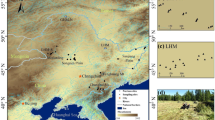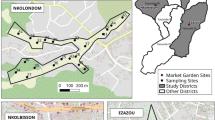Abstract
This study discusses the distribution and contamination levels of potentially harmful elements (As, Pb, Ni, and Cd) in the urban top soil of Penang Island, one of the most important urban areas in Malaysia. The total surface area of Penang Island is 297 km2. Thirty-one surface soil samples (0–20 cm) were collected, digested and analysed using Inductively Coupled Plasma Mass Spectrometry (ICP-MS) for As, Pb, Ni, and Cd. The result showed that the mean concentrations of selected metals in soils were arranged in the following decreasing order: Pb > As > Ni > Cd. In terms of different soil types, soils derived from quaternary deposit have higher mean concentration of Pb, Ni, and Cd as compared to the granite residual soils which accumulate higher mean concentration of As. On the spatial distribution maps, As, Pb, Ni, and Cd are mainly concentrated in the north-to-north eastern areas of Penang Island and near to the main city, which are characterized by major residential and business areas. Thus, it suggests that the anthropogenic source is the main contributor to the As, Pb, Ni, and Cd in the top soil of Penang Island. Both Pearson correlation analysis and principal component analysis showed a strong positive correlation between Pb and Cd which indicated that they may be derived from a similar source. The contamination factor assessment indicates moderate contamination level for Pb and Ni and no element enrichment level for As and Cd.






Similar content being viewed by others
References
Ağca N (2015) Spatial distribution of heavy metal content in soils around an industrial area in Southern Turkey. Arab J Geosci 8:1111–1123
Ahmad F, Yahaya AS, Farooqi MA (2006) Characterization and geotechnical properties of Penang residual soil with emphasis on landslides. Am J Environ Sci 2(4):121–128
Alloway BJ (2013) Heavy metals in soils. Springer, London
Benhaddya ML, Hadjel M (2013) Spatial distribution and contamination assessment of heavy metals in surface soils of Hassi Messaoud, Algeria. Environ Earth Sci 71:1473–1486
Birke M, Rauch U (2000) Urban geochemistry: investigations in the Berlin Metropolitan Area. Environ Geochem Health 22(3):233–248
Buttafuoco G, Tarvainen T, Jarva J, Guagliardi I (2016) Spatial variability trigger values of arsenic in the surface urban soils of the cities of Tampere and Lahti, Finland. Environ Earth Sci 75:896
Buttafuoco G, Guagliardi I, Tarvainen T, Jarva J (2017) A multivariate approach to study the geochemistry of urban topsoil in the city of Tampere, Finland. J. Geochem. Explor. 181:191–204
Cicchella D, Giaccio L, Dinelli E, Albanese S, Lima A, Zuzolo D, Valera P, De Vivo B (2015) GEMAS: spatial distribution of chemical elements in agricultural and grazing land soil of Italy. J Geochem Explor 154:129–142
Cobbing EJ, Pitfield PEJ, Darbyshire DPF, Mallick DIJ (1992) The Granites of the South-East Asian Tin Belt. British Geological Survey, Overseas Memoir, London
Department of Statistics Malaysia (2013). https://www.penang.gov.my/images/pdf/statistik%20sosioekonomi/1.%20DEMOGRAFI%20&%20EKONOMI.pdf. Accessed 10 Dec 2017
Dung TTT, Cappuyns V, Swennen R, Phung KY (2013) From geochemical background determination to pollution assessment of heavy metals in sediments and soils. Rev Environ Sci Bio/Technol 12:335–353
Fanning DS, Rabenhorst MC, Fitzpatrick RW (2017) Historical developments in the understanding of acid sulfate soils. Geoderma 308:191–206
Forum of Europian Geological Surveys (FOREGS) 2005. http://weppi.gtk.fi/publ/foregsatlas/maps_table.php. Accessed 10 Dec 2017
Ghani AA, Searle M, Robb L, Chung SL (2013) Transitional I S type characteristic in the main range granite, Peninsular Malaysia. J Asian Earth Sci 76:225–240
Ghazali S (2013) Sense of place and the politics of “insider-ness” in villages undergoing transition: the case of city kampung on Penang Island. In: Bunnell T et al (eds) Cleavage, connection and conflict in rural, urban and contemporary Asia. Springer Asia Series, Dordrecht
Guagliardi I, Chicchella D, De Rosa R (2012) A geostatistical approach to assess concentration and spatial distribution of heavy metals in urban soils. Water Air Soil Pollut 223:5983–5998
Guagliardi I, Chicchella D, De Rosa R, Ricca N, Buttafuoco G (2018) Geochemical sources of vanadium in soils: evidences in a southern Italy area. J Geochem Explor 184:358–364
Guo G, Wu F, Xie F, Zhang R (2012) Spatial distribution and pollution assessment of heavy metals in urban soils from southwest China. Journal of Environmental Sciences 24:410–418
Hakanson L (1980) An ecological risk index for aquatic pollution control: a sedimentological approach. Water Res 14:975–1001
Hamad SH, Schauer JJ, Shafer MM, Al-Rheem EA, Skaar PS, Heo J, Tejedor IT (2014) Risk assessment of total and bioavailable potentially toxic elements (PTEs) in urban soils of Baghdad-Iraq. Sci Total Environ 494–495:39–48
Hamzeh MA, Aftabi A, Mirzaee M (2011) Assessing geochemical influence of traffic and other vehicle-related activities on heavy metal contamination in urban soils of Kerman city, using a GIS-based approach. Environ Geochem Health 33:577–594
Hassan K (1990) A summary of quaternary geology investigations in Seberang Perai, Penang Island and Kuala Kurau. Bull Geol Soc Malays 26:47–53
Huang Y, Chen Q, Deng M, Japenga J, Li T, Yang X, He Z (2018) Heavy metal pollution and health risk assessment of agricultural soils in a typical peri-urban area in southeast China. J Environ Manage 207:159–168
Islam MS, Ahmed MK, Al-Mamun MH, Islam SMA (2017) Sources and ecological risk of heavy metals in soils of different land uses in Bangladesh. Pedosphere
Kabata-Pendias A, Mukherjee AB (2007) Trace elements from soil to human. Springer, Berlin
Lu SG, Bai SQ (2010) Contamination and potential mobility assessment of heavy metals in urban soils of Hangzhou, China: relationship with different land uses. Environ Earth Sci 60:1481–1490
Manta DS, Angelone M, Bellanca A, Neri R, Sprovieri M (2002) Heavy metals in urban soils: a case study from the city of Palermo (Sicily), Italy. Sci Total Environ 300:229–243
Mehr MR, Keshavarzi B, Moore F, Sharifi R, Lahijanzadeh A, Kermani M (2017) Distribution, source identification and health risk assessment of soil heavy metals in urban areas of Isfahan province, Iran. J Afr Earth Sci 132:16–26
Meuser H (2010) Contaminated urban soils. Springer, Dordrecht
Mirsal IA (2008) Soil pollution, 2nd edn. Springer, Berlin
Ng SWP, Chung SL, Robb LJ, Searle MP, Ghani AA, Whitehouse MJ, Oliver GJH, Sone M, Gardiner NJ, Roselee MH (2015) Petrogenesis of Malaysian Granitoids in the Southeast Asian tin belt: Part 1. Geochemical and Sr–Nd isotopic characteristics. Geol Soc Am Bull 127(9–10):1209–1237
Ong WS (1993) The geology and engineering geology of Pulau Pinang. Geological survey of Malaysia, Map report, p 7
Özkul C (2016) Heavy metal contamination in soils around the Tunçbilek Thermal Power Plant (Kütahya, Turkey). Environ Monit Assess 188:284
Pansu M, Gautheyrou J (2006) Handbook of soil analysis. Springer-Heidelberg, New York
Pekey H, Karakaş D, Ayberk S, Tolun L, Bakoğlu M (2004) Ecological risk assessment using trace elements from surface sediments of Izmit Bay (Northeastern Marmara Sea) Turkey. Mar Pollut Bull 48:946–953
Ramanitharan K, Steinberg L, Piringer G (2005) Geostatistical modeling and mapping of sediment contaminant concentrations. In: Calabrese EJ, Kostecki PT, Dragun J (eds) Contaminated soils, sediments and water. Springer, United States
Reimann C, Filzmoser C, Garrett RG (2005) Background and threshold: critical comparison of methods of determination. Sci Total Environ 346:1–16
Shamsuddin S, Sulaiman AB, Che Amat R (2012) Urban landscape factors that influenced the character of George Town, Penang UNESCO World Heritage Site. Procedia Soc Behav Sci 50:238–253
Simasuwannarong B, Satapanajaru T, Khuntong S, Pengthamkeerati P (2012) Spatial distribution and risk assessment of As, Cd, Cu, Pb, and Zn in topsoil at Rayong Province, Thailand. Water Air Soil Pollut 223:1931–1943
Slavkovic L, Ṧkrbic B, Miljevic N, Onjia A (2004) Principle component analysis of trace elements in industrial soils. Environ Chem Lett 2:105–108
Suntharalingam T (1984) Studies on the quartenary geology of Peninsular Malaysia. Geol Soc Malay Warta Geologi 10:101–110
Tay LT, Alkhasawneh MS, Ngah UK, Lateh H (2014) Landslide hazard mapping with new topographic factors: a study case of Penang Island, Malaysia. Aust J Basic Appl Sci 8(4):387–392
Town and Country Planning Department of Penang (DTCP) 2015. http://jpbd.penang.gov.my/index.php/en/. Accessed 10 Dec 2017
Tume P, Roca N, Rubio R, King R, Bech J (2018a) An assessment of the potentially hazardous element contamination in urban soils of Arica, Chile. J Geochem Explor 184:345–357
Tume P, González E, King RW, Monsalve V, Roca N, Bech J (2018b) Spatial distribution of potentially harmful elements in urban soils, city of Talcahuano, Chile. J Geochem Explor 184:333–344
Ungureanu T, Iancu GO, Pintilei M, Chicoș MM (2016) Spatial distribution and geochemistry of heavy metals in soils: a case study from the NE area of Vaslui county, Romania. J Geochem Explor 176:20–32
Webster R, Oliver MA (2001) Geostatistics for environmental scientists. Wiley, Chichester, pp 37–103
Wei B, Yang L (2010) A review of heavy metal contaminations in urban soils, urban road dusts and agricultural soils from China. Microchem J 94(2):99–107
Wong CSC, Li X, Thornton I (2006) Urban environmental geochemistry of trace metals. Environ Pollut 142:1–16
Wu C, Zhang L (2010) Heavy metal concentrations and their possible sources in paddy soils of a modern agriculture zone, southeastern China. Environ Earth Sci 60:45–56
Yukselen Y, Kaya A (2008) Suitability of the methylene blue test for surface area, cation exchange capacity and swell potential determination of clayey soils. Eng Geol 102:38–45
Zhai M, Kampunzu HAB, Modisi MP, Totolo O (2003) Distribution of heavy metals in Gaborone urban soils (Bostwana) and its relationship to soil pollution and bedrock composition. Environ Geol 45(2):171–180
Zhang C, McGrath D (2004) Geostatistical and GIS analyses on soil organic carbon concentrations in grassland of southeastern Ireland from two different periods. Geoderma 119:261–275
Zheng S, Shouyi L, Lingzhi H, Yaolong C (2010) Visualization programming for batch processing of contour maps based on VB and Surfer software. Adv Eng Softw 41:962–965
Zhengyu B, Shengying Q, Yueming H (2006) Contamination and distribution of heavy metals in urban soil in Zhangzhou City, Fujian, China. Chin J Geochem 25(1):4–4
Acknowledgements
This work was supported by the Institute of Research Management and Monitoring (IPPP), University of Malaya, under BKP Research Grant no. BK058-2015. Mr. Zaharudin Md Salleh, Mr. Zamrut Daunar, Miss. Nusyahira Ismail, and Mr. Shahrom Said from the Department of Geology and Mr. Saharuddin Zainal from Department of Chemistry, University of Malaya, are also acknowledged here for their technical support in geochemical analyses. We also thank two anonymous reviewers for their comments and suggestions.
Author information
Authors and Affiliations
Corresponding author
Additional information
Publisher's Note
Springer Nature remains neutral with regard to jurisdictional claims in published maps and institutional affiliations.
Rights and permissions
About this article
Cite this article
Abdul Hamid, F.A.Z., Abu Bakar, A.F., Ng, T.F. et al. Distribution and contamination assessment of potentially harmful elements (As, Pb, Ni, Cd) in top soil of Penang Island, Malaysia. Environ Earth Sci 78, 616 (2019). https://doi.org/10.1007/s12665-019-8626-0
Received:
Accepted:
Published:
DOI: https://doi.org/10.1007/s12665-019-8626-0




